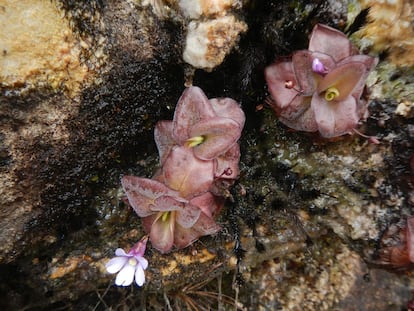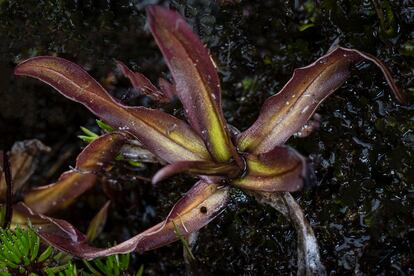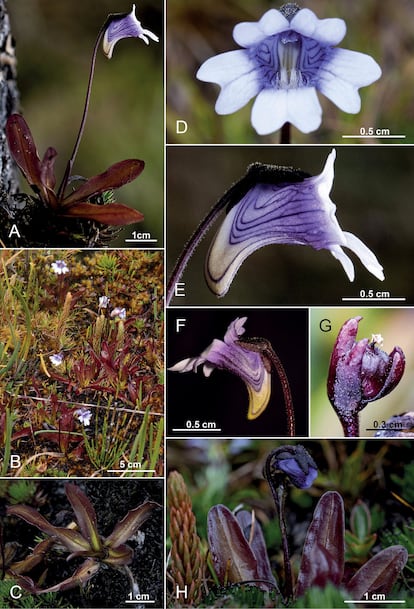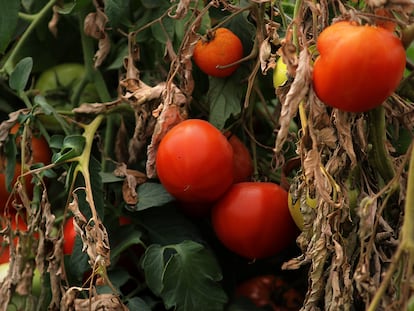How newly discovered South American carnivorous plants trap insects
The two species found in the south of Ecuador catch flies using small hairs on their leaves


Professor Álvaro Pérez and his colleagues walked for three days straight to reach the Cerro Plateado reserve, the highest part of the Condor mountain range on the border between Ecuador and Peru. It was the second visit ever by a group of scientists. The purpose of the trip was to gather species of native plants from the unexplored ecosystem. “When we were on the top of the hill, we saw something strange and beautiful that we had never seen before,” the professor recalls with excitement. From the rock walls bloomed a tiny carnivorous plant, with a purple flower and minuscule hairs on its brown leaves. Pérez and his colleagues took photos and collected samples to take to the laboratories of the Pontifical Catholic University of Ecuador.
They made their first trip in 2016 and the second in 2021. At first sight, Pérez and his colleagues knew that they had something new in their hands. After studying the roots, leaves and flowers in depth, they found that the species was previously unknown to science. They called it Pinguicula ombrophila. “Its name means lover of rain or love of humidity,” explains Pérez, a biology professor at the Pontifical Catholic University. The name is an homage to the mountaintops of the Condor, full of moss, fog and icy wind. The discovery was published last week in the scientific magazine Phytokeys, in an article authored by Pérez; Francisco Tobar, a scientist at Ecuador’s National Herbarium; Kevin Burgess, a researcher at Ohio State University-Columbus; and Tilo Henning, from the Leibniz Center for Agricultural Landscape Research in Germany, one of the world’s foremost experts in carnivorous plants.

In addition to the discovery of the Pinguicula ombrophila, the article also details the discovery of another carnivorous plant in Ecuador, the Pinguicula jimburensis. The species was named in honor of the black lakes of Jimburá, a high zone in the Yacurí National Park, where it was found. Professor Pérez and his colleagues saw it for the first time on the ground, while they walked on a path around the lakes. “It grows on a humid highland on the border with Peru,” he says. This plant is notable for the shape of its leaves. “It differs from other similar plants because its leaves are long, a reddish color that works to protect the plant from solar radiation in the plains where it lives,” the scientist explains.
The Pinguicula jimburensis grows in a swampy area. It lives alongside mosses and small shrubs, including a species of valerian discovered a few months ago. The plant measures no more than eight centimeters. It is a terrestrial herb with red leaves and purple flowers that feeds on small diptera, tiny flies that fly and fall on its leaves with the winds. The two new species catch their prey in a particular way: “They have glandular hairs on their leaves that emit a sticky liquid, so that the insects that come close to it stay stuck and die,” explains the researcher. As they decompose, the tiny flies’ exoskeletons release nitrogen, which is a necessary element for the plants’ life cycle.

Professor Pérez explains that the cinematic idea of carnivorous plants that attract brightly colored insects and snap them up to eat them is based on reality, but represents another family of carnivores. “That is how the famous Venus flytraps work. They are very different from those we have found in Ecuador.” According to the researchers, these two new species add to the “exceptional biodiversity of the area.” At the time of the discovery, only one species of Pinguicula had been documented in Ecuador. It was found by Alexander Von Humboldt in his expeditions at the beginning of the 19th century. “With these two new discoveries, it can be said that we tripled that diversity, and our country now has three carnivorous species,” says Pérez.

The discovery of these two new species of Andean flora helps to recognize these high mountain ecosystems as a critical point of biodiversity. Above all, the discovery can serve to improve their conservation. “The habitat of these carnivorous plants urgently needs protection,” explains Pérez. In fact, as soon as the Pinguicula ombrophila, scientists classified it as a vulnerable species. It had just been born to science, and it was already in danger. The reasons: threats from climate change, increased temperatures in its climate and human destruction of the ecosystem. “This is how we make known the diversity of the region and the importance of caring for the forests and highlands.”
Sign up for our weekly newsletter to get more English-language news coverage from EL PAÍS USA Edition
Tu suscripción se está usando en otro dispositivo
¿Quieres añadir otro usuario a tu suscripción?
Si continúas leyendo en este dispositivo, no se podrá leer en el otro.
FlechaTu suscripción se está usando en otro dispositivo y solo puedes acceder a EL PAÍS desde un dispositivo a la vez.
Si quieres compartir tu cuenta, cambia tu suscripción a la modalidad Premium, así podrás añadir otro usuario. Cada uno accederá con su propia cuenta de email, lo que os permitirá personalizar vuestra experiencia en EL PAÍS.
¿Tienes una suscripción de empresa? Accede aquí para contratar más cuentas.
En el caso de no saber quién está usando tu cuenta, te recomendamos cambiar tu contraseña aquí.
Si decides continuar compartiendo tu cuenta, este mensaje se mostrará en tu dispositivo y en el de la otra persona que está usando tu cuenta de forma indefinida, afectando a tu experiencia de lectura. Puedes consultar aquí los términos y condiciones de la suscripción digital.
More information
Archived In
Últimas noticias
The complicated life of Francesca Albanese: A rising figure in Italy but barred from every bank by Trump’s sanctions
How Japan is trying to avert ‘digital defeat’
Reinhard Genzel, Nobel laureate in physics: ‘One-minute videos will never give you the truth’
Pinochet’s victims grapple with José Antonio Kast’s rise in Chile
Most viewed
- Pablo Escobar’s hippos: A serious environmental problem, 40 years on
- Why we lost the habit of sleeping in two segments and how that changed our sense of time
- Trump’s obsession with putting his name on everything is unprecedented in the United States
- The Florida Keys tourist paradise is besieged by immigration agents: ‘We’ve never seen anything like this’
- Charles Dubouloz, mountaineering star, retires at 36 with a farewell tour inspired by Walter Bonatti










































